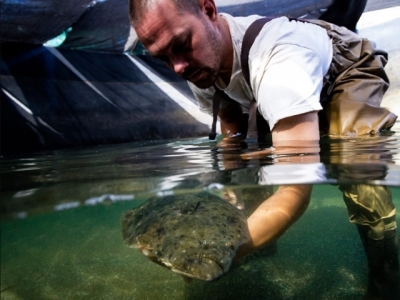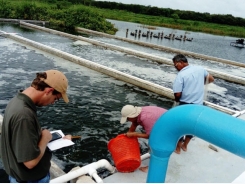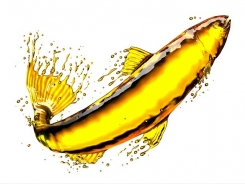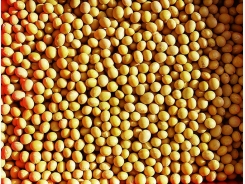Research delves into enrichment of live feed for larval fish

Oregon State team aims to improve nutrition for California yellowtail, halibut
Halibut broodstock, one of the species targeted for the initial testing of the liposome feed technology. Photo by Mark Drawbridge, Hubbs-SeaWorld Research Institute.
Better feed means better fish. That simple equation explains a recent grant from the Foundation for Food and Agriculture Research of almost $276,000 to scientists in Oregon State University’s Department of Fisheries and Wildlife (an amount matched by Hubbs-SeaWorld Research Institute, Oregon State University and Reed Mariculture).
The initial goal of the two-year grant is to improve the feed for, and therefore the production of, California yellowtail and halibut. The expectation is that the technology will be applicable to other species and available for adoption by industry within three years of project completion.
The problem being addressed arises because fish live in water and so what they eat is found there also, said Matt Hawkyard, an Oregon State research associate and a member of the research team.
“When you take artificially produced food particles and put them in the water, anything that has a high affinity for water may be rapidly lost,” he said.

Juvenile yellowtail, one of the initial species in a trial to enrich live feeds. Photo credit – Mark Drawbridge, Hubbs-SeaWorld Research Institute.
This leaching is especially fast for the microscopic particles eaten by brine shrimp and rotifers, often used as live feeds for larval finfish in a hatchery or nursery setting. Smaller than the diameter of a human hair, these particles have a lot of surface area and quickly lose nutrients.
Enriching the food value to finfish of brine shrimp and rotifers is resultingly difficult, and so these live feeds often lack critical compounds; poor nutrition leads to higher rates of mortality and even malformation in farmed fish. Fish and shellfish not only survive but thrive in water because they have membranes within their cells that keep water away from vital water-soluble molecules.
Researchers, therefore, decided to take a page from Mother Nature and put these membranes to work. They are doing this with liposomes, tiny hollow spheres with a lipid, or fatty, outer layer that is insoluble in water. Therefore, what’s in the liposome is protected from water’s dissolving effect. When eaten, digestion breaks down the liposomes and releases the contents. This then provides a means to get needed enrichment into live feeds.
What goes inside the liposomes are nutrients, such as the water-soluble amino acid taurine, which is essential for fish growth and development, Hawkyard said. He added that the liposome production has been used by the pharmaceutical industry to deliver high-value drugs. The OSU researchers have developed their own cost-effective and high-volume nutrient-bearing liposome manufacturing methods.
“We’re now able to make large quantities of these liposomes and use them for enriching live feeds,” Hawkyard said.
The result is as much as a 100-fold improvement in the effectiveness of enriching rotifers with taurine, as compared to what happens when the amino acid is simply added to water. Using this technology to enrich the live feeds could provide fish more complete nutrition.
Ultimately, the goal is to get a rotifer or brine shrimp to more closely mimic what is normally eaten by the larval stage of finfish in the wild. Achieving that will require coming up with the right recipe that balances many possible nutrients and enrichments.
Getting this improved feed to fish as early as possible in their development is critical, said Mark Drawbridge, senior research scientist at Hubbs-SeaWorld Research Institute (HSWRI).
“Most of these species are new and have not been cultured,” he said. “So, you’re in a situation where the larval stage often becomes the bottleneck in the whole process in terms of producing enough fish to be commercially viable.”

Larval stage brine shrimp (artemia) with liposomes in its gut. The liposomes, which are hollow spheres, contain a green fluorescent dye. The dye is water-soluble and is a proxy for water-soluble nutrients that can be placed in the liposome, thereby enriching the nutritional value of the brine shrimp to fish larvae. Photo courtesy of Oregon State University.
HSWRI has been collaborating with Oregon State on projects for years, said Drawbridge, so contributing to the grant is a logical next step, as is the California-based institute’s involvement in the liposome nutrient project.
While the Oregon State research team is working on designing the feed, HSWRI will be putting together larvae feeding trials, with the goal being further refinement of the feed based upon the results. In the first phase, larval growth will be evaluated. As the project progresses, longer-term impacts will be assessed, such as malformation that cannot be detected until the juvenile phase. In time, commercial adoption of the technology will be the ultimate gauge of success.
Eventually, it may be possible to devise a formulated feed for fish larvae, eliminating the need to raise a living food source. That could then allow a more precise tailoring and optimization of fish larvae feed as well as greatly reducing complexity and cost, according to Drawbridge.
While this approach been successful with some aquatic species, the direct method faces some hurdles when it comes to getting fish to bite particles that may be slowly drifting by or even almost stationary.
“The larvae, especially when they’re very young, are preprogrammed to eat another moving object, and so that’s part of the challenge,” Drawbridge said.
Có thể bạn quan tâm
Phần mềm

Phối trộn thức ăn chăn nuôi

Pha dung dịch thủy canh

Định mức cho tôm ăn

Phối trộn phân bón NPK

Xác định tỷ lệ tôm sống

Chuyển đổi đơn vị phân bón

Xác định công suất sục khí

Chuyển đổi đơn vị tôm

Tính diện tích nhà kính

Tính thể tích ao hồ



 Evaluating commercial, dietary pre-, pro- and synbiotics in…
Evaluating commercial, dietary pre-, pro- and synbiotics in…  A look at phospholipids in aquafeeds
A look at phospholipids in aquafeeds